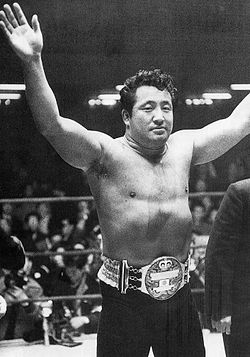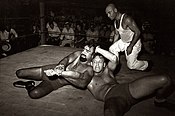Professional wrestling in Japan

| Part of a series on |
| Professional wrestling |
|---|
 |
Professional wrestling in Japan has existed for several decades. The first Japanese person to involve themselves in
Professional wrestling style
Professional wrestling on television
Since its beginning, Japanese professional wrestling depended on
The advent of
In 2009, due to the bearish global economy, NTV cancelled all wrestling programming, including NOAH's Power Hour (lesser affiliates still air large cards), marking the end of a tradition going back to Rikidōzan.
Since 2014, various New Japan Pro-Wrestling live specials have been broadcast on AXS TV in the United States.[7]
Professional wrestling promotions
Relations with professional wrestling beyond Japan
Foreigners in Japanese circuits
Since its establishment, professional wrestling in Japan heavily incorporated foreigners (called
In recent years, many of North America's most popular wrestlers, such as
As a result of the introduction of lucha libre into Japan, major Mexican stars also compete in Japan. The most popular Mexican wrestler to compete in Japan is Mil Máscaras, who is credited with introducing the high-flying moves of lucha libre to Japanese audiences,[8] which then led to the style called lucha-resu, later embodied by Tiger Mask.
Foreign wrestlers from diverse backgrounds have earned huge followings, sometimes greater than those of Japanese top rosters in respective Japanese promotions they have wrestled in. American Stan Hansen, Indian Tiger Jeet Singh, Canadian Abdullah the Butcher, and British wrestler Dynamite Kid were among those cited as top foreign grapplers in a poll of Japanese fans:
| Rank | Wrestlers |
|---|---|
| 1 | |
| 2 | |
| 3 | |
| 4 | |
| 5 | |
| 6 | |
| 7 | |
| 8 | |
| 9 | |
| 10 | The Road Warriors
|
Japanese stars abroad
All Japan Pro Wrestling and New Japan Pro-Wrestling, as well as others, have also sent wrestlers to compete in the likes of the
Before the advent of cable television some Japanese wrestlers in the U.S. adopted names that often were inconsistent and often portrayed by more than one Japanese wrestler, such as "Tokyo Joe" (
Some joshi stars from AJW had wrestled for the World Wrestling Federation in the 1980s and 1990s, with The Jumping Bomb Angels and Bull Nakano known for being particularly successful.
Gaea Japan once had a working agreement with World Championship Wrestling in the mid-1990s, when the latter brought in wrestlers from Gaea to bolster the ranks of their then-fledgling women's division, with Akira Hokuto becoming the first and only WCW Women's Champion, and a WCW Women's Cruiserweight Championship was even introduced and defended in Gaea shows.
Recent examples of Japanese wrestlers working in foreign promotions include
See also
- List of professional wrestling attendance records in Japan
- List of professional wrestling promotions in Japan
References
- ^ Svinth, Joseph (2000). "Japanese Professional Wrestling Pioneer: Sorakichi Matsuda". Retrieved 2009-07-15.
- ^ "Rikidōzan". Puroresu.com. 1995. Retrieved 2009-07-15.
- ^ Great Hisa (2009-07-26). "The Great Hisa's Puroresu Dojo". Puroresu.com. Retrieved 2009-07-26.
- ^ Wilson, Kevin. "Legends". Puroresu Central. Retrieved 2009-07-26.
- ^ Tanabe, Hisaharu (1992-11-12). "Chono vs. Takada (one of the earliest reference to "puroresu" by Hisaharu Tanabe)". Google Groups. Retrieved 2009-07-15.
- ^ a b c "Puroresu Dojo Introduction". Puroresu.com. 1995. Retrieved 2009-07-08.
- ^ "AXS announces New Japan TV deal, official details, time slot, debut date and more". Wrestling Observer Newsletter. November 24, 2014. Archived from the original on November 28, 2014. Retrieved November 24, 2014.
- ^ The Wrestling Gospel According to Mike Mooneyham Archived 2008-11-13 at the Wayback Machine [dead link]
- ^ Researched by Nikkan Sports. Retrieved 2012-09-26.
- ^ "Hamada (TNA Roster)". TNA Official Website. Archived from the original on 2010-08-18. Retrieved 2010-08-28.
